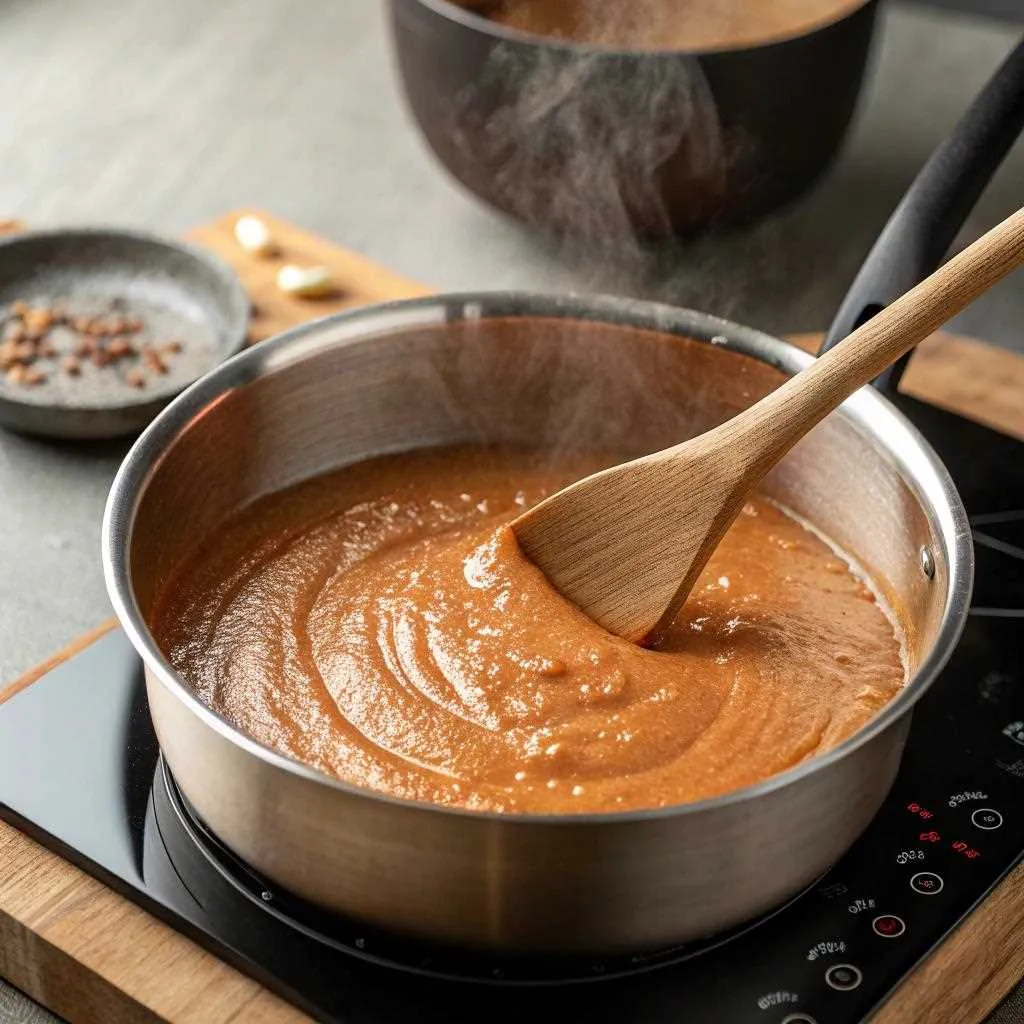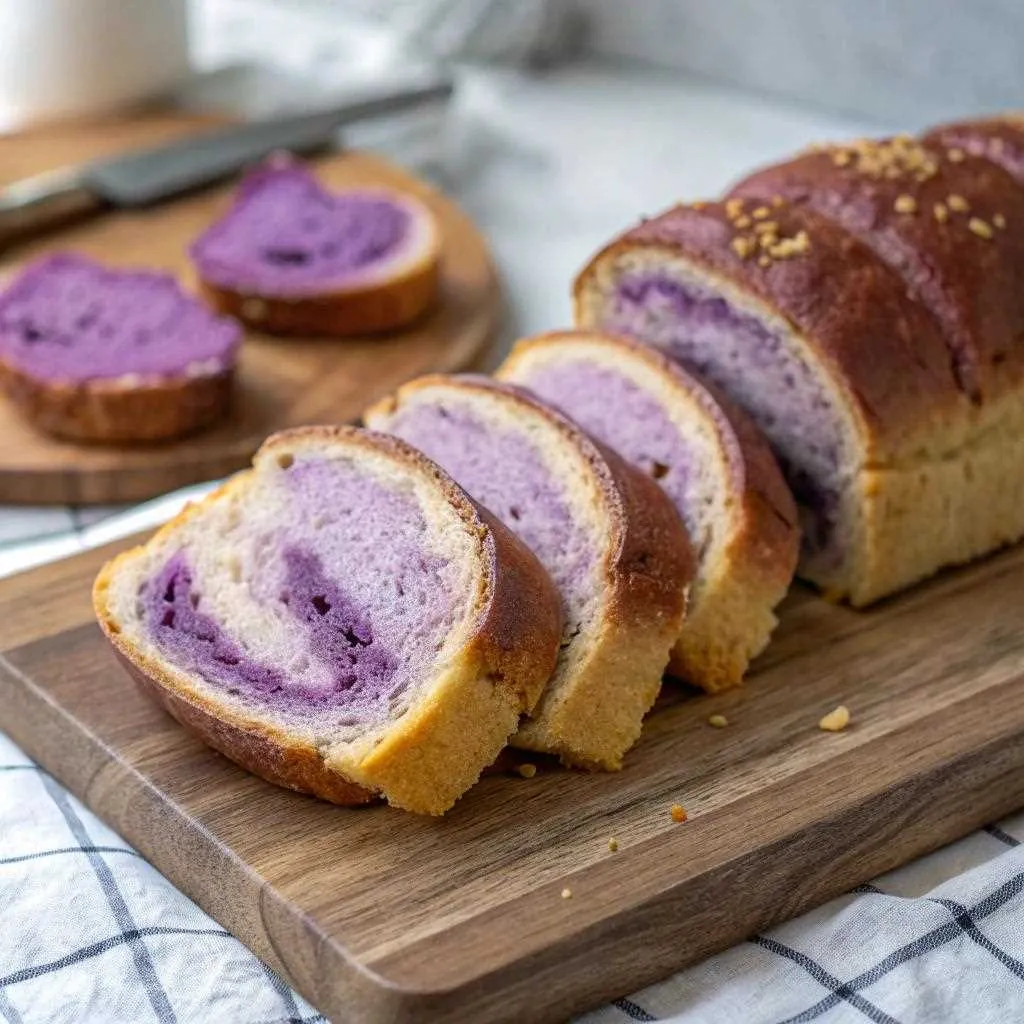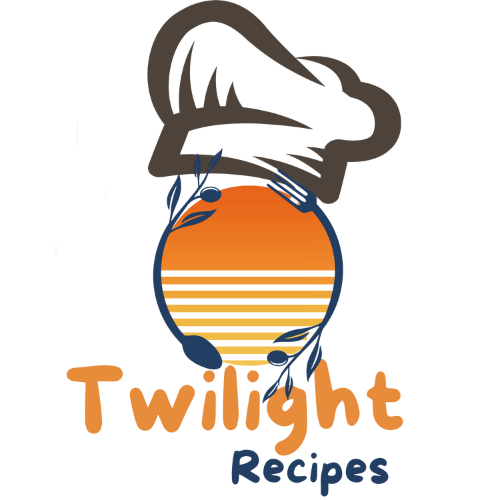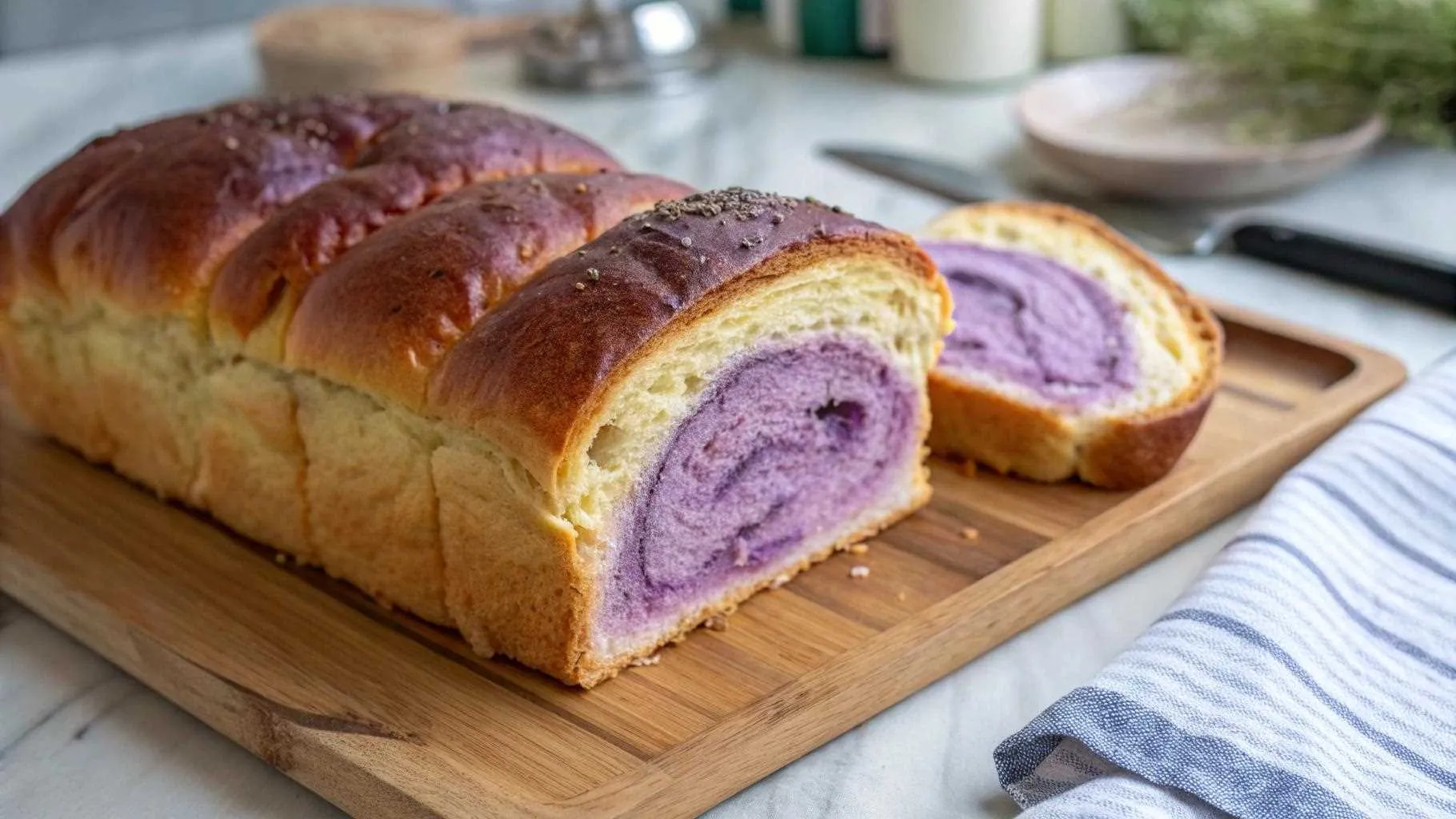Table of Contents
Introduction
Can I add ube extract to a milk bread recipe? Absolutely! Adding ube extract to milk bread enhances its nutty, vanilla-like flavor while giving it a beautiful purple hue. This combination results in a soft, fluffy loaf with a touch of natural sweetness.
I recently experimented with adding ube extract to my favorite milk bread recipe, and the results were amazing! But how much extract should you use? Does it affect the dough? In this guide, I’ll cover everything from techniques, substitutes, common mistakes, and a full step-by-step recipe to help you make the perfect ube milk bread at home.
What Is Japanese Milk Bread?
The Unique Characteristics of Japanese Milk Bread
Japanese milk bread, also known as Shokupan, is famous for its incredibly soft and fluffy texture. Unlike regular white bread, it has a slightly sweet taste and a melt-in-your-mouth consistency. What makes it so special?
- Ultra-soft crumb: Thanks to its unique preparation method, milk bread has an airy, delicate structure.
- Mildly sweet and buttery taste: It pairs well with both sweet and savory spreads.
- Longer shelf life: The method used to make it helps retain moisture, keeping the bread fresh longer.
How the Tangzhong Method Makes It Soft and Fluffy
The secret to Japanese milk bread’s texture lies in the Tangzhong method. This involves pre-cooking a portion of the flour with liquid to create a smooth, thick paste. This technique:
✔️ Retains moisture, keeping the bread soft for days.
✔️ Enhances gluten development, creating an airy structure.
✔️ Gives the bread a rich, slightly chewy texture.
Why Milk Bread Is a Perfect Base for Ube Flavor
The light sweetness of milk bread makes it an ideal canvas for flavor variations. Since ube (purple yam) has a naturally mild sweetness with nutty and vanilla-like undertones, it blends well with milk bread’s taste and texture.
✅ Ube extract adds a deep purple hue without changing the dough structure.
✅ The sweet and nutty flavors complement the slight sweetness of the bread.
✅ Ube-infused milk bread pairs well with butter, condensed milk, or even coconut jam!
What Is Ube Extract and How Does It Affect Milk Bread?
Understanding Ube and Its Flavor Profile
Ube, pronounced “oo-beh”, is a purple yam native to the Philippines. It has a naturally sweet, nutty, and slightly vanilla-like flavor, making it a popular ingredient in desserts, breads, and pastries. Traditionally, ube is boiled, mashed, and used in cakes, ice cream, and fillings.
However, instead of using fresh ube, many bakers opt for ube extract because it:
✔️ Provides a stronger, more consistent ube flavor.
✔️ Adds a beautiful purple hue without affecting the dough’s texture.
✔️ Is easy to mix into batters, doughs, and frostings.
Natural vs. Artificial Ube Extract
When shopping for ube extract, you’ll find both natural and artificial versions.
- Natural Ube Extract: Made from real purple yam, offering a mild flavor and lighter color.
- Artificial Ube Extract: Contains food coloring and artificial flavoring, giving a stronger taste and deeper purple color.
For baking, a combination of natural extract and ube powder can create the best balance of flavor and color.
Ube Extract vs. Ube Powder: Key Differences
Many people confuse ube extract and ube powder, but they’re not the same!
| Feature | Ube Extract | Ube Powder |
|---|---|---|
| Form | Liquid | Fine powder |
| Flavor | Strong, concentrated | Mild, earthy |
| Use | Added to wet ingredients | Rehydrated or mixed into batters |
| Effect on Bread | Enhances color & taste | Adds texture but requires hydration |
For ube milk bread, ube extract is the best choice because it blends seamlessly with the dough without altering the moisture content.
💡 Pro Tip: Want a naturally vibrant purple hue? Combine ube extract with ube powder! This creates a rich color and deeper flavor without relying on artificial food coloring.
Can I Add Ube Extract to a Milk Bread Recipe? Best Techniques & Ratios
Absolutely! Ube extract is a fantastic way to infuse milk bread with a delicious nutty, vanilla-like flavor and a beautiful purple color. However, adding it the right way is key to ensuring the perfect taste and texture.
How Ube Extract Affects Dough Texture and Color
When you add ube extract to milk bread, a few things happen:
✅ Color: The bread develops a rich lavender to deep purple hue, depending on the amount of extract used.
✅ Flavor: The subtle sweetness and nuttiness of ube enhance the overall taste, making it slightly more dessert-like.
✅ Moisture Content: Since extract is a liquid, adding too much can alter the dough’s hydration balance.
🛑 Avoid this mistake!
Adding too much ube extract can make the dough sticky and difficult to knead, leading to a dense or gummy texture. The key is to adjust the flour or liquid ratios accordingly.
Recommended Measurement for Perfect Flavor Balance
To get the best results without overpowering the dough, follow this guide:
| Amount of Flour | Recommended Ube Extract | Result |
|---|---|---|
| 2 ½ cups (320g) | 1 tsp | Subtle, light purple color |
| 3 cups (380g) | 1 ½ tsp | Balanced flavor & color |
| 4 cups (500g) | 2 tsp | Strong ube taste, deep purple |
💡 Tip: Start with 1 tsp of ube extract, then gradually increase if you want a stronger ube flavor.
Does Ube Extract Change the Rise and Baking Process?
Not really! As long as you:
✔️ Don’t add too much extract, which can increase moisture and slow gluten development.
✔️ Allow proper proofing time, since colder extracts can slightly slow yeast activity.
✔️ Use high-quality yeast, especially if your extract contains preservatives that might interfere with fermentation.
Best Way to Incorporate Ube Extract in Milk Bread
To distribute the flavor and color evenly:
✅ Step 1: Add ube extract to the wet ingredients (milk, eggs, butter) before mixing with flour.
✅ Step 2: Mix thoroughly to prevent streaks or uneven coloring.
✅ Step 3: Adjust flour slightly if the dough feels too wet.
By following these steps, you’ll get soft, evenly flavored, and perfectly purple ube milk bread!
Step-by-Step Recipe for Ube Milk Bread
Now that we know how ube extract affects milk bread, let’s put it all together! This ube milk bread recipe uses the Tangzhong method to ensure an ultra-soft texture while incorporating the perfect amount of ube extract for color and flavor.
Ingredients Needed for Ube Milk Bread
For the Tangzhong (Starter Paste):

- 3 tbsp (25g) bread flour
- ½ cup (120ml) whole milk or water
For the Dough:
- 2 ½ cups (320g) bread flour
- 3 tbsp (40g) sugar
- 1 tsp salt
- 1 tbsp instant yeast
- ½ cup (120ml) warm milk (110°F / 43°C)
- 1 large egg
- 2 tbsp butter (softened)
- 1 ½ tsp ube extract
- ½ tsp vanilla extract (optional, enhances sweetness)
Step 1: Prepare the Tangzhong (Secret to Softness!)
Tangzhong is a pre-cooked flour paste that helps retain moisture in the dough, making the bread extra soft.
1️⃣ In a small saucepan, whisk together 3 tbsp flour and ½ cup milk over medium-low heat.
2️⃣ Stir continuously until it thickens into a smooth, pudding-like paste (about 2-3 minutes).
3️⃣ Remove from heat and let it cool to room temperature.
Step 2: Mixing the Dough and Adding Ube Extract
1️⃣ In a large mixing bowl, whisk together flour, sugar, salt, and yeast.
2️⃣ In a separate bowl, combine warm milk, egg, butter, ube extract, and Tangzhong paste.
3️⃣ Gradually add the wet ingredients to the dry ingredients and mix until a shaggy dough forms.
💡 Tip: If using a stand mixer, use the dough hook attachment on low speed.
Step 3: Kneading and First Proofing
1️⃣ Knead the dough for 10-12 minutes until it becomes smooth and elastic.
2️⃣ Place the dough in a greased bowl, cover with a clean towel, and let it rise for 1 hour (until doubled in size).
Step 4: Shaping, Second Rise, and Baking
1️⃣ Punch down the dough to release air bubbles.
2️⃣ Divide into equal portions and shape into loaves or rolls.
3️⃣ Place into a greased loaf pan or baking tray. Cover and let it rise for another 45 minutes.
4️⃣ Preheat oven to 350°F (175°C).
5️⃣ Brush the dough with egg wash (1 egg + 1 tbsp milk) for a golden crust.
Step 5: Baking and Serving Suggestions

1️⃣ Bake for 25-30 minutes, or until the top is golden brown and the loaf sounds hollow when tapped.
2️⃣ Let it cool on a wire rack before slicing.
🍞 Serving Ideas:
- Enjoy it warm with butter or condensed milk.
- Use it to make ube French toast.
- Pair it with coconut jam (kaya) or cream cheese spread.
💡 Love creamy desserts? Try this Crème Brûlée Recipe with Milk for another indulgent treat!
Tips for Making the Best Ube Milk Bread
Making ube milk bread is pretty simple, but a few expert tips can take your loaf from good to bakery-level perfection! Here’s what you need to know.
1. How to Ensure a Soft and Fluffy Texture
The Tangzhong method already helps keep the bread soft, but you can take it a step further:
✔️ Use bread flour instead of all-purpose flour – This helps create a stronger gluten structure, leading to a fluffier texture.
✔️ Knead the dough well – The dough should pass the windowpane test (stretch it thin without tearing) to ensure proper gluten development.
✔️ Don’t over-flour the dough – A slightly sticky dough is fine; too much flour can make the bread dense.
✔️ Let it rise fully – Underproofing leads to a heavy loaf, while overproofing can cause it to collapse in the oven.
2. Adjusting Sweetness and Flavor with Ube Extract
Ube extract naturally adds a mild sweetness to the dough, but you can tweak it based on your preference:
✔️ For a sweeter bread: Add an extra tablespoon of sugar.
✔️ For a richer flavor: Use half ube extract + half vanilla extract.
✔️ For a stronger ube taste: Add ½ teaspoon of ube powder along with the extract.
💡 Tip: Ube extract’s flavor develops over time, so the next day, your bread will taste even better!
3. Storing and Reheating for Maximum Freshness
✔️ Room Temperature: Store in an airtight container for up to 3 days.
✔️ Refrigerate: Wrap the loaf in plastic wrap and refrigerate for up to a week.
✔️ Freeze: Slice and store in a ziplock bag for up to 3 months.
🔥 Best way to reheat? Microwave for 10 seconds or toast lightly for a crisp outside and soft inside.
💡 Want more fun dessert ideas? Check out this Festive Candy Corn Fudge Recipe!
Substitutes for Ube Extract in Milk Bread
If you don’t have ube extract on hand, don’t worry! There are several alternatives that can still give you a similar flavor, color, or texture. Here are the best substitutes:
1. Can I Use Vanilla Extract Instead of Ube Extract?
Yes! While vanilla extract won’t provide the same purple color or nutty notes, it adds a lovely sweet and creamy flavor.
✔️ Best ratio: Replace 1 tsp of ube extract with 1 ½ tsp vanilla extract.
✔️ To enhance the color: Add a few drops of purple food coloring or ube powder.
✔️ Flavor twist: Combine vanilla extract with a hint of coconut extract for a tropical twist!
2. Alternative Natural Ingredients for Ube Flavor
If you want a natural alternative, here are a few ingredients that can work:
| Substitute | Flavor Profile | How to Use |
|---|---|---|
| Ube Powder | Earthy, slightly sweet | Mix with warm milk before adding to dough |
| Mashed Purple Sweet Potato | Naturally sweet, rich texture | Replace ¼ cup of flour with mashed potato |
| Taro Powder | Creamy, nutty, mild sweetness | Dissolve in milk for a smoother blend |
| Pandan Extract | Sweet, floral, tropical | Use in place of ube extract for a unique flavor |
💡 Tip: If using ube powder or mashed purple sweet potato, you may need to adjust the liquid in the recipe slightly to maintain the right dough consistency.
3. How to Enhance the Purple Color Without Extract
If you want that signature purple bread but don’t have ube extract, here’s what you can do:
✔️ Use purple food coloring – A few drops will give your bread a rich violet hue.
✔️ Add blueberry or blackberry juice – Natural and slightly tangy!
✔️ Blend purple sweet potato or taro into the dough – Adds both color and moisture.
By using these alternatives, you can still achieve a delicious, colorful, and flavorful ube-inspired milk bread!
Common Mistakes When Using Ube Extract
Using ube extract in milk bread is simple, but a few common mistakes can affect the texture, flavor, and color of your bread. Here’s what to avoid:
1. Adding Too Much Extract: How It Affects Dough Consistency
It might be tempting to add extra ube extract for a stronger flavor, but too much can:
🛑 Make the dough too wet, causing a sticky or dense texture.
🛑 Weaken gluten development, leading to a flat or deflated loaf.
🛑 Create an overpowering artificial taste, especially with certain brands.
✔️ Fix: Stick to 1 to 2 teaspoons per recipe and adjust other liquids accordingly.
2. Why Artificial Ube Extract Can Taste Overpowering
Not all ube extracts are created equal! Some brands use artificial flavors and food coloring, which can result in:
⚠️ A chemical aftertaste when too much is used.
⚠️ A fake, candy-like sweetness instead of an earthy, nutty flavor.
⚠️ A bitter taste if overbaked, due to artificial dyes.
✔️ Fix: Choose high-quality extracts with real ube or balance artificial extracts with natural ube powder.
3. Mistakes That Lead to Dry or Dense Bread
🚫 Skipping the Tangzhong paste – The bread won’t stay soft without it.
🚫 Not kneading the dough enough – Poor gluten development leads to a dense loaf.
🚫 Underproofing or overproofing – A rushed rise can result in a heavy texture, while overproofing can make the bread collapse.
✔️ Fix: Follow proofing times carefully and use the poke test—if the dough slowly springs back, it’s ready to bake!
By avoiding these mistakes, you’ll get perfectly soft, flavorful ube milk bread every time!
FAQs About Ube and Milk Bread
Here are the most common questions about ube extract, Japanese milk bread, and substitutions to help you master this recipe!
1. What Makes Japanese Milk Bread Different?
Japanese milk bread, or Shokupan, stands out because of its ultra-soft, fluffy texture. The secret? The Tangzhong method, a technique where a portion of flour is cooked with liquid to create a paste-like roux before mixing into the dough.
✔️ Keeps the bread softer for longer
✔️ Gives a slightly chewy, bouncy texture
✔️ Enhances moisture without making it dense
Unlike regular white bread, Japanese milk bread is sweeter, lighter, and more pillowy, making it perfect for sweet and savory pairings.
2. What Is the Difference Between Ube Extract and Ube Powder?
Many people confuse ube extract and ube powder, but they serve different purposes:
| Feature | Ube Extract | Ube Powder |
|---|---|---|
| Form | Liquid | Fine powder |
| Flavor | Strong, concentrated | Mild, earthy |
| Color Impact | Adds deep purple hue | Lighter purple, needs enhancement |
| Usage | Mixed into liquids | Hydrated before adding to recipes |
💡 Best option? Use both! Ube extract gives rich color and aroma, while ube powder adds a natural, subtle ube flavor.
3. What Are the Ingredients in Ube Bread?
Traditional ube bread often includes:
✔️ Flour – Bread flour for a fluffy texture
✔️ Tangzhong paste – Helps with softness and moisture
✔️ Milk & Butter – Adds richness and creaminess
✔️ Sugar – Balances the ube’s nutty flavor
✔️ Ube Extract & Ube Powder – For color and flavor
✔️ Yeast & Salt – For fermentation and taste
This combination creates a perfectly balanced, aromatic, and vibrant bread!
4. Can I Use Vanilla Extract Instead of Ube Extract?
Yes! While vanilla extract won’t give the signature purple color or nutty flavor, it adds sweetness and enhances richness in the bread.
✔️ Substitution ratio: Use 1 ½ tsp vanilla extract for every 1 tsp ube extract.
✔️ To maintain color: Add purple food coloring or ube powder.
✔️ Flavor alternative: Try a mix of vanilla and coconut extract for a tropical twist!
💡 Best Option? If you don’t have ube extract, vanilla plus mashed purple sweet potato is the closest natural alternative.
Conclusion & Final Thoughts
Adding ube extract to a milk bread recipe is a game-changer! The nutty, vanilla-like sweetness pairs beautifully with the soft, fluffy texture of Japanese milk bread, creating a unique and visually stunning loaf.
To get the best results:
✔️ Use 1 to 2 teaspoons of ube extract for balanced flavor and color.
✔️ Incorporate the Tangzhong method to keep the bread ultra-soft.
✔️ Avoid common mistakes like adding too much extract or overproofing the dough.
✔️ Experiment with ube powder, vanilla extract, or coconut extract for variations.
Whether you’re making this for breakfast, a snack, or a fun ube-flavored dessert, this recipe is sure to impress!
💡 Want more delicious recipes? Check out:
👉 Banana Bread Recipe for Bread Machine
👉 Crème Brûlée Recipe with Milk
👉 Festive Candy Corn Fudge
Try this ube milk bread recipe and let us know how it turns out! Tag us on social media and share your creations. 🍞💜

